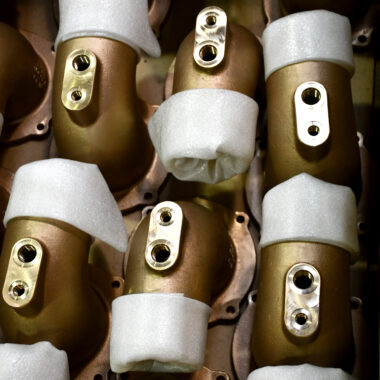The Top Methods for Light Weight Aluminum Casting That You Required to Know
From the conventional sand casting method to the intricate financial investment spreading procedure, each method provides distinct advantages that provide to various job demands. As we navigate via the leading methods for aluminum spreading, it comes to be obvious that grasping these methods is crucial for attaining optimum results.
Sand Casting Strategy
The Sand Casting Technique is a basic method in light weight aluminum spreading, widely made use of for its cost-effectiveness and convenience in producing elaborate steel shapes. This technique entails producing a mold and mildew made from compacted sand right into which molten light weight aluminum is poured, allowing it to strengthen and take the shape of the mold. Among the key benefits of sand casting is its capacity to produce intricate geometries with fairly reduced tooling expenses, making it an eye-catching choice for manufacturers aiming to create one-of-a-kind components.
In the sand spreading process, a pattern of the last part is pressed right into a fine sand combination contained within a flask. Once the pattern is gotten rid of, a tooth cavity standing for the final component's form is left in the sand. Molten aluminum is after that poured into the tooth cavity, loading the area and taking on the accurate details of the pattern. After the light weight aluminum cools and solidifies, the sand mold and mildew is damaged away, exposing the freshly cast aluminum part. Sand spreading is commonly utilized in numerous markets, including automotive, aerospace, and art factories, as a result of its capability to create both tiny and big steel parts with intricate styles.

Financial Investment Casting Process
A complex approach utilized in light weight aluminum casting is the Investment Casting Process, understood for its capability to generate highly described and detailed steel elements. Referred to as the lost-wax casting procedure, this technique dates back thousands of years and stays a popular option in various industries due to its flexibility and precision.
The financial investment spreading procedure begins with the production of a wax pattern, which is coated with a ceramic covering to develop a mold and mildew. The wax is then thawed out, leaving a tooth cavity in the shape of the wanted part. Molten aluminum is put into the ceramic mold and mildew, filling the dental caries and taking on the intricate details of the original wax pattern.
This approach is preferred for its capability to generate complex forms with outstanding surface finish and dimensional accuracy. It is typically used in the production of aerospace elements, fashion jewelry, and commercial equipment where detailed layouts are called for. The financial investment casting procedure supplies high repeatability and can create get rid of very little machining needed, making it an affordable choice for many applications.
Irreversible Mold And Mildew Technique
Using a various technique from the Investment Casting Refine, the Permanent Mold Method in light weight aluminum casting offers a distinctive technique for developing metal parts. In this approach, a reusable mold and mildew, typically made of steel or cast iron, is utilized to form the molten aluminum. The mold and mildew is preheated to a certain temperature prior to the light weight aluminum is poured right into it. The warmth transfer from the liquified metal to the mold and mildew aids in solidifying the aluminum promptly, reducing the cooling time compared to sand spreading.
One of the key benefits of the Permanent Mold And Mildew Technique is the boosted surface finish and dimensional precision of the castings generated. This method is additionally understood for its capability to produce high-strength light weight aluminum elements with consistent high quality. Furthermore, the reusable nature of the mold and mildew makes it a cost-effective option for tool to high volume production runs.
Die Spreading Modern Technology
Using sophisticated production processes, die casting technology provides a highly efficient approach for producing elaborate light weight aluminum parts. This technique entails injecting liquified light weight aluminum into a steel mold, referred to as a die, at high pressures. The die is specially designed to form the aluminum right into the wanted form, resulting in high accuracy and superb surface area coating.
Pass away casting offers a number of benefits. It enables the production of complex forms with slim wall surfaces, tight resistances, and click smooth surface areas, making it perfect for applications where appearances and precision are important. Furthermore, die casting makes it possible for fast manufacturing prices, lowering overall production time and prices.

Lost Foam Casting Method
Pass away casting modern technology's effectiveness and precision in creating light weight aluminum components lead the means for checking out the Lost Foam Casting Approach as a corresponding production visit site strategy. Lost Foam Spreading, also understood as evaporative pattern spreading, is an approach that utilizes foam patterns to create detailed light weight aluminum components.
One of the crucial benefits of Lost Foam Casting is its capability to produce complex layouts with intricate details that may be challenging to achieve via typical casting methods. As markets continue to require light-weight yet sturdy elements, Lost Foam Casting shows to be a valuable method in the world of aluminum casting.
Verdict
In final thought, recognizing the leading Read Full Report methods for aluminum casting is critical for attaining high-quality lead to the manufacturing procedure. Sand casting, financial investment spreading, long-term mold and mildew, pass away spreading, and shed foam casting are all efficient approaches for creating light weight aluminum get rid of different levels of intricacy. By grasping these techniques, makers can ensure that their items fulfill the preferred requirements and requirements for efficiency and sturdiness.
From the traditional sand casting approach to the elaborate financial investment spreading procedure, each method uses distinct advantages that cater to different project demands.The Sand Spreading Technique is a basic technique in aluminum casting, extensively made use of for its cost-effectiveness and adaptability in producing detailed steel forms. Lost Foam Spreading, likewise understood as evaporative pattern casting, is a technique that uses foam patterns to create intricate light weight aluminum components. As industries proceed to require light-weight yet resilient components, Lost Foam Spreading proves to be an important method in the realm of aluminum casting.
Sand spreading, investment casting, permanent mold, pass away spreading, and shed foam spreading are all effective methods for creating aluminum parts with different levels of complexity.